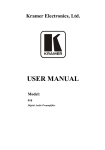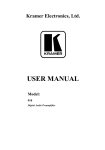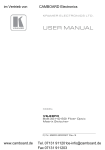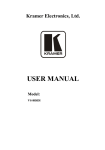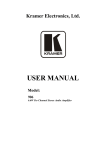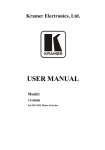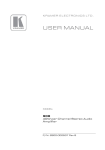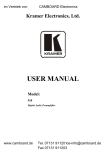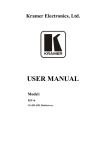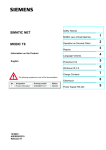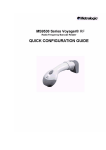Download USER MANUAL - Kramer Electronics
Transcript
Kramer Electronics, Ltd.
USER MANUAL
Model:
PIP-4
4 input Picture-in-Picture Inserter
Contents
Contents
1
2
2.1
3
3.1
4
5
5.1
5.2
Introduction
Getting Started
Quick Start
Overview
Recommendations for best performance
Defining the PIP-4, 4 input Picture-in-Picture Inserter
Connecting the PIP-4, 4 input Picture-in-Picture Inserter
Connecting a PC to the PIP-4 via RS-232 for Remote Operation
Connecting a PC to the PIP-4 via Ethernet for Remote Operation
1
1
2
3
3
4
6
7
7
6
6.1
Operating the PIP-4 Locally
Operating the PIP-4 Using the Front Panel Buttons
9
9
6.2
The OSD Menu
11
6.3
7
7.1
Operating the PIP-4 Using the Mouse
Operating the PIP-4 Remotely
Operating the PIP-4 Using the PIP-4 Controller Software
12
13
13
8
9
10
11
11.1
11.2
Resetting the PIP-4 Parameters to Factory Defaults
Technical Specifications
Default Communication Parameters
Communication Protocol 3000
Protocol 3000 Syntax
Command Parts Details
19
20
20
21
21
21
5.2.1
5.2.2
6.1.1
6.1.2
6.2.1
6.2.2
7.1.1
7.1.2
7.1.3
7.1.4
7.1.5
7.1.6
7.1.7
7.1.8
7.1.9
7.1.10
7.1.11
7.1.12
Connecting the Ethernet Port Directly to a PC
Connecting the ETHERNET Port via a Network Hub
Manipulating Video Panes
Navigating the OSD Menu
Display Submenu
Utility Submenu
The Menu Bar
The Quick Access Toolbar
Connecting to the Device
Windows Position
Connection Status
Changing the Layer Order
Implementing Multiple Actions At Once
Changing the Video Characteristics of a Channel
Upgrading the Firmware
Displaying the Device Details
Setting the IP Network Parameters
Displaying the PIP-4 Software Version Number
7
8
9
10
11
11
14
15
15
16
17
17
17
17
18
18
19
19
i
Contents
Figures
Figure 1: PIP-4 Front Panel
Figure 2: PIP-4 Rear Panel
Figure 3: Connecting the PIP-4, 4 input Picture-in-Picture Inserter
Figure 4: Local Area Connection Properties Window
Figure 5: Internet Protocol (TCP/IP) Properties Window
Figure 6: Video Pane Manipulation Buttons
Figure 7: OSD Menu Buttons
Figure 8: PIP-4 Controller Software Main Window
Figure 9: Quick Access Toolbar
Figure 10: Connect Window
Figure 11: Window Manipulation
Figure 12: Windows Setup Window
Figure 13: Device Details
Figure 14: About PIP-4 Controller Window
4
5
6
8
8
9
10
13
15
15
16
17
18
19
Tables
Table 1: PIP-4 Front Panel Features
Table 2: PIP-4 Rear Panel Features
Table 3: PIP-4 Menu Items
Table 4: The Display Submenu Options
Table 5: The Utility Submenu Options
Table 6: PIP-4 Controller Software Features
Table 7: Menu Bar Options
Table 8: Quick Access Toolbar Options
Table 9: Technical Specifications of the PIP-4, 4 input Picture-in-Picture Inserter
Table 10: Default Communication Parameters
Table 11: Instruction Codes for Protocol 3000
ii
4
5
11
11
11
14
14
15
20
20
22
KRAMER: SIMPLE CREATIVE TECHNOLOGY
Introduction
1
Introduction
Welcome to Kramer Electronics! Since 1981, Kramer Electronics has been
providing a world of unique, creative, and affordable solutions to the vast range of
problems that confront the video, audio, presentation, and broadcasting
professional on a daily basis. In recent years, we have redesigned and upgraded
most of our line, making the best even better! Our 1,000-plus different models now
appear in 11 groups 1 that are clearly defined by function.
Congratulations on purchasing your Kramer PIP-4, 4 input Picture-in-Picture
Inserter, which is ideal for:
• Video production studios for source monitoring
• Teleconferencing using one screen
• Home theater multi-channel monitoring
• Security applications
The package includes the following items:
• PIP-4, 4 input Picture-in-Picture Inserter
• RC-IR3 Infrared Remote Controller (including batteries and manual2)
• Power adapter (5V DC output)
• This user manual 2
2
Getting Started
We recommend that you:
• Unpack the equipment carefully and save the original box and packaging
materials for possible future shipment
• Review the contents of this user manual
1 GROUP 1: Distribution Amplifiers; GROUP 2: Switchers and Matrix Switchers; GROUP 3: Control Systems; GROUP 4:
Format/Standards Converters; GROUP 5: Range Extenders and Repeaters; GROUP 6: Specialty AV Products; GROUP 7: Scan
Converters and Scalers; GROUP 8: Cables and Connectors; GROUP 9: Room Connectivity; GROUP 10: Accessories and Rack
Adapters; GROUP 11: Sierra Products
2 Download up-to-date Kramer user manuals from http://www.kramerelectronics.com
1
Getting Started
2.1
Quick Start
The following quick start chart summarizes the basic setup and operation steps for
the PIP-4.
2
KRAMER: SIMPLE CREATIVE TECHNOLOGY
Overview
3
Overview
The high performance Kramer desktop PIP-4 is a picture-in-picture inserter for
composite video signals.
The PIP-4 features:
• A multi-standard, picture-in-picture video inserter that accepts up to four
composite video sources and displays them all on the same screen
simultaneously
• s-Video and composite video outputs
• Non-volatile memory that retains the last setting 1
With the PIP-4, you can:
• Position sources on the screen as desired and select their size dynamically
using a mouse or by selection from a list
• Freeze the output
• Output video as both s-Video and composite signals
In addition, the PIP-4:
• Includes 10-bit video A/D and D/A converters throughout the unit, ensuring
the highest quality video
• Can be operated locally via:
The front panel buttons
A user-friendly OSD (On-Screen Display) menu
• Can be operated remotely via an IR remote controller, RS-232 and Ethernet
• Is rugged and dependable
3.1
Recommendations for best performance
To achieve the best performance:
• Connect only good quality connection cables 2 thus avoiding interference,
deterioration in signal quality due to poor matching, and elevated noise levels
(often associated with low quality cables)
• Avoid interference from neighboring electrical appliances and position your
PIP-4 away from moisture, excessive sunlight and dust
1 Provided the last setting was valid for at least 30 seconds before switching the machine off
2 The complete list of Kramer cables is available from http://www.kramerelectronics.com
3
Defining the PIP-4, 4 input Picture-in-Picture Inserter
4
Defining the PIP-4, 4 input Picture-in-Picture Inserter
Figure 1 and Table 1 define the front panel of the PIP-4, 4 input Picture-in-Picture
Inserter.
Figure 1: PIP-4 Front Panel
Table 1: PIP-4 Front Panel Features
#
1
2
3
4
4
Feature
IR LED
IR Sensor
POWER LED
IN 1
IN 2
Input Selector
Buttons
IN 3
IN 4
5
Button
6
/– Button
7
Button
8
/+ Button
9
10
MENU Button
MOVE Button
11
SIZE Button
12
QUAD Button
Navigation
Buttons
Function
Lights yellow when the unit receives IR signals
IR signal receiver
Lights green when the unit is powered on
Press to select input 1
Press to select input 2
Press to select input 3
Press to select input 4
In MOVE mode, moves the selected pane down.
In SIZE mode, shrinks the selected pane.
In DISTORT mode, moves the bottom of the pane down.
In the OSD menu, moves the cursor down one option
In MOVE mode, moves the selected pane left.
When in SIZE mode, shrinks the selected pane.
In DISTORT mode, moves the right hand side of the selected pane to the left.
In the OSD menu, moves the cursor to the left
In MOVE mode, moves the selected pane up.
In SIZE mode, expands the selected pane.
In DISTORT mode, moves the bottom of the pane up.
In the OSD menu, moves the cursor up one option
In MOVE mode, moves the selected pane right.
When in SIZE mode, expands the selected pane.
In DISTORT mode, moves the right hand side of the selected pane to the right.
In the OSD menu, moves the cursor to the right
Press to display the OSD menu. Press again to exit the OSD menu
Moves the active pane. Press to enter the MOVE mode followed by one of the
arrow buttons
Resizes the active pane while retaining the aspect ratio. Press to enter the
SIZE mode followed by one of the arrow buttons
Press to display all 4 inputs in equally sized panes
KRAMER: SIMPLE CREATIVE TECHNOLOGY
Defining the PIP-4, 4 input Picture-in-Picture Inserter
#
Feature
Function
13
ENTER Button
14
15
ESC Button
DISTORT Button
16
17
FULL Button
MOUSE USB Connector
When in the OSD menu, press to select the current option or to confirm an
action
Exits the OSD Menu
Distorts the active pane by changing the aspect ratio. Press to enter the
DISTORT mode followed by one of the arrow buttons
Expands the active pane to full screen
Connect USB/PS/2 mouse for operating the OSD menu
Figure 2 and Table 2 define the rear panel of the PIP-4, 4 input Picture-in-Picture
Inserter.
Figure 2: PIP-4 Rear Panel
Table 2: PIP-4 Rear Panel Features
#
18
19
20
21
22
23
24
Feature
IN 1
IN 2
IN 3
IN 4
Composite Video BNC Input
Connectors
Y/C 4-pin s-Video Output Connector
CV BNC Output Connector
RESET Button
OUTPUT
ETHERNET RJ-45 Connector
RS-232 9-pin D-sub Connector
5V DC Power Connector
Function
Connect to composite video source 1
Connect to composite video source 2
Connect to composite video source 3
Connect to composite video source 4
Connect to the s-Video acceptor
Connect to the composite video acceptor
Press and hold while switching the unit on to reset all
parameters to factory default values (see Section 8)
Connect to LAN for remote operation using a PC
Connect to a PC or other device for remote operation
Connect to supplied power adapter, center pin positive
5
Connecting the PIP-4, 4 input Picture-in-Picture Inserter
5
Connecting the PIP-4, 4 input Picture-in-Picture Inserter
To connect 1 the PIP-4 as illustrated in the example in Figure 3:
1. Connect a composite video player source to the IN 1 BNC connector 2.
2. Connect a composite video player source to the IN 2 BNC connector2.
3. Connect an s-Video display acceptor to the Y/C OUTPUT 4-pin s-Video
connector 3.
4. Connect a composite video display acceptor to the CV OUTPUT BNC
connector3.
5. Optional—for remote operation, connect the ETHERNET RJ-45 connector to
a LAN to which the PC is connected (see Section 5.2.2) 4.
6. Connect the supplied power adapter to the unit and to the mains supply (not
shown in Figure 3).
Figure 3: Connecting the PIP-4, 4 input Picture-in-Picture Inserter
1 Switch off the power on each device before connecting it to your PIP-4. After connecting your PIP-4, switch on its power and then
switch on the power to each device
2 The device supports up to 4 simultaneous inputs
3 You do not have to connect both outputs
4 The device can also be operated remotely via the RS-232 port
6
KRAMER: SIMPLE CREATIVE TECHNOLOGY
Connecting the PIP-4, 4 input Picture-in-Picture Inserter
5.1
Connecting a PC to the PIP-4 via RS-232 for Remote Operation
You can connect to the PIP-4 via an RS-232 connection using, for example, a PC.
Note that a null-modem adapter/connection is not required.
To connect to the PIP-4 via RS-232:
• Connect the RS-232 9-pin D-sub rear panel port on the PIP-4 unit via a 9-wire
straight cable (only pin 2 to pin 2, pin 3 to pin 3, and pin 5 to pin 5 need to be
connected) to the RS-232 9-pin D-sub port on your PC
5.2
Connecting a PC to the PIP-4 via Ethernet for Remote Operation
You can connect to the PIP-4 via Ethernet using either of the following methods:
• Direct connection to the PC using a crossover cable (see Section 5.2.1)
• Connection via a network hub, switch, or router, using a straight-through
cable (see Section 5.2.2)
5.2.1 Connecting the Ethernet Port Directly to a PC
You can connect the Ethernet port of the PIP-4 to the Ethernet port on your PC, via
a crossover cable with RJ-45 connectors.
This type of connection is recommended for identifying the
PIP-4 with the factory configured default IP address
To connect directly to your PC and to configure it:
1. Using a crossover cable, connect the unit directly to your PC.
2. Right-click the My Network Places icon on your desktop.
3. Select Properties.
4. Right-click Local Area Connection Properties.
5. Select Properties.
The Local Area Connection Properties window appears.
6. Select the Internet Protocol (TCP/IP) and click the Properties Button (see
Figure 4).
7
Connecting the PIP-4, 4 input Picture-in-Picture Inserter
Figure 4: Local Area Connection Properties Window
7. Select Use the following IP Address, and fill in the details as shown in
Figure 5.
8. Click OK.
Figure 5: Internet Protocol (TCP/IP) Properties Window
5.2.2 Connecting the ETHERNET Port via a Network Hub
You can connect the Ethernet port of the PIP-4 to the Ethernet port on a network
hub or network router, via a straight-through cable with RJ-45 connectors.
8
KRAMER: SIMPLE CREATIVE TECHNOLOGY
Operating the PIP-4 Locally
6
Operating the PIP-4 Locally
You can operate your PIP-4 locally via:
• The front panel buttons (see Section 6.1)
• A mouse (see Section 6.3)
• An IR remote controller
6.1
Operating the PIP-4 Using the Front Panel Buttons
The front panel buttons are used to:
• Manipulate video panes
• Navigate the OSD menu
Note: If there is no mouse activity for 20 seconds, the OSD closes automatically.
6.1.1 Manipulating Video Panes
You can use the front panel buttons (displayed within gray boxes in Figure 6) to
manipulate the display (such as, changing size and aspect ratio) of each of the four
inputs independently.
Figure 6: Video Pane Manipulation Buttons
The buttons operate in the following manner:
• IN 1 to IN 4: Select the input to manipulate
• , , –, +: Move up, down, left/decrease and right/increase
• Move, Size, Quad, Distort and Full: Select an operation to perform on the
pane
Example
To increase the size of the Input 3 window:
1. Press IN 3.
The Input 3 window becomes active. Its outline becomes black and flashes.
2. Press SIZE.
Size is displayed in the Input 3 pane.
3. Repeatedly press or press and hold the + button until the window is the
required size.
4. Press ESC.
9
Operating the PIP-4 Locally
6.1.2 Navigating the OSD Menu
You can use the front panel OSD menu buttons (see Figure 7) to navigate the OSD
in order to modify the video parameters (such as brightness and contrast) of each
input independently.
Figure 7: OSD Menu Buttons
The buttons operate in the following manner:
• MENU: Display the OSD 1. Press again to exit the OSD from any level
• ENTER: Enter a menu item or accept a parameter value
• +, – : Increase/decrease a parameter value
• , , , : Navigate through the menu items
• ESC: Exit the OSD menu, a menu item or parameter value
Note: If there is no mouse activity for 20 seconds, the OSD closes automatically.
Example
To vertically mirror the Input 3 pane:
1. Press IN 3.
The Input 3 window becomes active. Its outline becomes black and starts to
flash.
2. Press MENU.
The OSD is displayed and Display is highlighted.
3. Press .
The cursor moves to Screen.
4. Press .
Source is highlighted.
5. Press ENTER.
The Source Setup screen is displayed.
6. Check the Mirror V box.
7. Click on the X to close the OSD.
1 The menu times-out after 20 seconds
10
KRAMER: SIMPLE CREATIVE TECHNOLOGY
Operating the PIP-4 Locally
6.2
The OSD Menu
The OSD menu provides access to the PIP-4 configuration. Using the OSD menu
you can change the general display and individual input settings.
Table 3: PIP-4 Menu Items
Menu Item
DISPLAY
UTILITY
Submenu
Quad Full
Source
Zoom
Overscan/Normal
Brightness
Contrast
Sharpness
Hue
Color
Store
Recall
Erase
Description
Selects all 4 inputs to display
Sets each input video pane’s characteristics
Zooms the center of the selected pane to double size
Selects whether to display in normal or overscan mode
Sets the brightness of each input video signal
Sets the contrast of each input video signal
Sets the sharpness of each input video signal
Sets the hue of each input video signal
Sets the color of each input video signal
Stores the current setting in one of the 10 presets
Recalls one of the 10 presets
Erases one of the 10 presets
6.2.1 Display Submenu
Table 4 defines the Display submenu features.
Table 4: The Display Submenu Options
Item
Full/Quad
Source
Zoom
Overscan/Normal
Parameter
Not applicable
Window
Source video
Mirror V
Mirror H
Freeze
Blank
Not applicable
Not applicable
Values
Full/Quad
0–3
0–3
On/Off
On/Off
On/Off
On/Off
On/Off
Overscan/Normal
6.2.2 Utility Submenu
Table 5 defines the utility submenu.
Table 5: The Utility Submenu Options
Item
Brightness
Contrast
Sharpness
Parameter
Channel
Brightness
Channel
Contrast
Channel
Sharpness
1–4
1–255
1–4
1–255
1–4
0–15
Values
11
Operating the PIP-4 Locally
Hue
Color
6.3
Item
Parameter
Channel
Hue
Channel
Color
1–4
1–255
1–4
1–255
Values
Operating the PIP-4 Using the Mouse
The mouse control operates in the following manner:
• Left-click on a pane to select it
• Click and hold within a pane, and drag to move it
• Click and hold on the border of a pan, and drag to change the size and aspect
ratio of the pane. Dragging the border of a pane over the opposite border of
the pane flips the pane over (mirrors the pane)
• Right click anywhere to display the OSD Menu
In the OSD Menu, left click to navigate the OSD and modify parameters
Note: If there is no mouse activity for 20 seconds, the OSD closes automatically.
Example
To change the brightness of Input 2:
1. Left-click on the input 2 pane.
2. Right-click to display the OSD.
3. Use the mouse to navigate to Utility > Brightness.
4. Left-click on Brightness.
The Brightness parameter setting is displayed.
5. Modify the setting to the required value using the Brightness left and right
arrows.
6. Click on the X to close the OSD.
Example
To vertically mirror the Input 3 pane:
1. Right-click to display the OSD.
2. Use the mouse to navigate to Display > Source.
3. Click on the Source Video right arrow to select Input 3.
4. Click Mirror V.
5. Click on the X to close the OSD.
12
KRAMER: SIMPLE CREATIVE TECHNOLOGY
Operating the PIP-4 Remotely
7
Operating the PIP-4 Remotely
You can operate your PIP-4 remotely via the following:
• IR remote controller
• Ethernet over a LAN
• RS-232 serial commands transmitted by a touch screen system, PC, or other
serial controller
7.1
Operating the PIP-4 Using the PIP-4 Controller Software
The PIP-4 Control application 1 is used to control the device via either RS-232 or
Ethernet.
For details regarding connecting to the Ethernet port on the PIP-4, see Section 5.2.
The Controller software requires the following:
• Windows™ XP, Vista or Windows™ 7
• Microsoft .Net Framework version 3.5
To install the Controller software, download the software and run the setup file.
After installation, running the Controller software for the first time displays a
window similar to that shown in Figure 8.
Figure 8: PIP-4 Controller Software Main Window
1 Download the application from http://www.kramerelectronics.com
13
Operating the PIP-4 Remotely
Table 6: PIP-4 Controller Software Features
1
2
3
4
#
Feature
Status Indicator
Menu Bar
Quick Access Toolbar
Window Position
Function
Indicates whether the controller software is online, online in Take
mode, offline, or offline in Take mode
Operate and configure the device using the Menu Bar options (see
Section 7.1.1)
Operate and configure the device using the quick access toolbar
buttons (see Section 7.1.2)
Modify window size and position by dragging and dropping
individual windows (see Section 7.1.4)
Note: Unless the device is in off-line mode (set by pressing the Take button),
when a change is made on the device (for example, a different output is selected),
the change is reflected almost immediately in the main window of the Controller
Software. Similarly, if a change is made in the Controller Software, the change is
reflected almost immediately on the device.
7.1.1 The Menu Bar
The menu bar options are shown in Table 7.
Table 7: Menu Bar Options
Menu Bar Options
Sub Menu
FILE
Open
Save
Exit
DEVICE
Connect/Disconnect
Take/Update
DISPLAY
SETUP
ABOUT
14
Description
Open an existing configuration
Save the current configuration
Exit the PIP-4 Controller software
Connect or disconnect to the device (see Section 7.1.3)
Press Take to put the device in off-line mode. Press
Update to implement waiting changes and return the
device to on-line mode (see Section 7.1.7)
Device Details
Retrieve, display and edit the device details, such as,
model, unit name, version, etc. See Section 7.1.10
Firmware Update
Update the device firmware
Quad
Set the screen to display the quad 4-window configuration
Full
Set the screen to display the single-window configuration
Zoom
Enlarges and displays a movable region as a full screen
Refresh
Retrieve all information from the device
Sets the following signal characteristics for each input:
Effects
Brightness, Contrast, Sharpness, Hue and Color
Sets the following source characteristics:
Source
Select Channel, Connect to Video Source, Mirror V, Mirror
H, Freeze and Blank
Turn Overscan On
Turns on overscan
Stores the current video configuration in one of 10 preset
Store
memories
Recalls the video configuration from one of 10 preset
Recall
memories
Erases the video configuration from one of the 10 preset
Erase
memories
Displays the Step-in Software and Kramer company details
KRAMER: SIMPLE CREATIVE TECHNOLOGY
Operating the PIP-4 Remotely
7.1.2 The Quick Access Toolbar
The Quick Access Toolbar buttons are shown in Figure 9 and described in
Table 8.
Figure 9: Quick Access Toolbar
Table 8: Quick Access Toolbar Options
Feature
Description
Open an existing configuration
Save the current configuration
Connects to and disconnects from the device (see
Section 7.1.3)
Press Take to enable multiple off-line changes to be made.
Press Update to implement the changes (see Section 7.1.7)
Set the screen to display the quad 4-window configuration
Set the screen to display the single-window configuration
7.1.3 Connecting to the Device
To connect to the device:
1. Click the Connect button.
The window shown in Figure 10 appears.
Figure 10: Connect Window
15
Operating the PIP-4 Remotely
2. Select the required method of connection option button:
• For Ethernet, enter the IP address and Port number of the device. To set
the default IP address and Port number, press the Default button.
• For a serial connection, select the required Com port from the drop-down
list.
• For a USB connection 1, select the required USB device from the dropdown menu.
If necessary, click Refresh Ports to update the USB port list.
3. Click Connect.
If the connection is successful, the main window shown in Figure 8 appears.
If the connection is not successful, a Timeout error message appears.
7.1.4 Windows Position
The windows can be manually manipulated in size and position.
Figure 11: Window Manipulation
To change the size of a window:
• Click, hold and drag the required window handle at the right hand side,
bottom, or bottom right hand corner of the window
To change the position of a window:
• Click, hold and drag anywhere in the window
1 At the time of printing this option is not available
16
KRAMER: SIMPLE CREATIVE TECHNOLOGY
Operating the PIP-4 Remotely
7.1.5 Connection Status
The connection status can be one of the following states:
• Online—the device is connected and being updated in real-time by the
software
• Online, in take mode (not updating device)—the device is connected but
changes are only implemented when the Update button is pressed
• Offline—in Take mode
• Offline—the device is not connected
7.1.6 Changing the Layer Order
You can change the order in which the windows are arranged simply by clicking
on a window to raise it to the top.
7.1.7 Implementing Multiple Actions At Once
To implement multiple actions at once:
1. Press the Take button to put the device in off-line mode.
The button changes to the Update button and the device is in off-line mode.
2. Perform the required actions, such as, switching and layer order changes.
3. Press the Update button.
The button changes to the Take button and all changes are implemented.
7.1.8 Changing the Video Characteristics of a Channel
To change the video characteristics of a channel:
1. Click Setup > Effects.
The Display Effects window appears as shown in Figure 12.
Figure 12: Windows Setup Window
17
Operating the PIP-4 Remotely
2. Click and hold on the slider, dragging it to modify the required characteristic.
For fine control of the slider, use the arrow buttons on your keyboard.
3. Click Close.
The channel video characteristic is changed.
7.1.9 Upgrading the Firmware
To upgrade the firmware:
1. Download the latest firmware file from http:www.kramerelectronics.com.
2. Click Device > Firmware Upgrade.
3. Browse to the firmware file that you downloaded.
4. Click Open.
The current firmware version is checked and if this is older than the
downloaded firmware, the downloaded firmware is installed.
Note: Do not interrupt the uploading process or the device may be damaged.
5. Ignore the reset message and when the process is complete, reset the device
by disconnecting the power and then reconnecting it.
7.1.10 Displaying the Device Details
To display the device details:
1. Click Device > Device Details.
The device details are displayed, such as, model and serial number as shown
in Figure 13.
Figure 13: Device Details
18
KRAMER: SIMPLE CREATIVE TECHNOLOGY
Resetting the PIP-4 Parameters to Factory Defaults
7.1.11 Setting the IP Network Parameters
To set the IP network parameters:
1. Click Device > Device Details.
2. Under Connectivity, edit the required parameter(s).
3. Click Set Value.
A confirmation message appears.
4. Click OK.
The parameter is set.
5. Reboot the device.
7.1.12 Displaying the PIP-4 Software Version Number
To display the PIP-4 Software version number:
1. From the Menu bar, click About.
The About PIP-4 Controller window appears as shown in Figure 14.
Figure 14: About PIP-4 Controller Window
2. Click OK to close the window.
8
Resetting the PIP-4 Parameters to Factory Defaults
For a list of the factory default parameters see Section 10.
To reset all parameters to factory default values:
1. Disconnect the power from the device.
2. Press and hold the Reset button on the rear panel of the unit.
3. While holding the Reset button, reconnect the power to the device.
4. Wait until the video pane(s) are displayed. Release the Reset button.
The parameters are reset to factory default values.
19
Technical Specifications
9
Technical Specifications
Table 9 lists the technical specifications 1 of the PIP-4, 4 input Picture-in-Picture
Inserter.
2
Table 9: Technical Specifications of the PIP-4, 4 input Picture-in-Picture Inserter
INPUTS:
4 composite video 1Vpp @75Ω on BNC connectors
OUTPUTS:
1 s-Video 1Vpp, 0.3Vpp @75Ω on a 4-pin s-Video connector
1 composite video 1Vpp @75Ω on a BNC connector
DIGITAL RESOLUTION:
10 bit
S/N RATIO:
60db (weighted)
YC SEPARATION:
Adaptive 4-line digital comb filters
MEMORY:
Non-volatile memory for storage of 2 setups
CONTROL:
Front-panel, OSD, RS-232 and Ethernet
POWER SOURCE:
5V DC, 450mA
OPERATING
TEMPERATURE:
0° to +55°C (32° to 131°F)
STORAGE TEMPERATURE: -45° to +72°C (-49° to 162°F)
10
HUMIDITY:
10% to 90%, RHL non-condensing
DIMENSIONS:
21.5cm x 17.7cm x 4.4cm (8.5" x 7" x 1.7”) W, D, H
WEIGHT:
0.8kg (1.76lbs) approx.
ACCESSORIES:
Power Supply, RC-IR3 Infrared Remote Control
OPTIONS:
RK-1 rack adapter
Default Communication Parameters
Table 10: Default Communication Parameters
Protocol 3000 (Default)
Baud Rate:
Data Bits:
Stop Bits:
Parity:
Command Format:
Example (Output 1 to Input 1):
115,200
8
1
None
ASCII
#AV 1>1<CR>
Ethernet
Default Settings
IP Address: 192.168.1.39
Subnet Mask:
Gateway:
TCP Port #: 5000
UDP Port #: 50000
Reset Settings
Power cycle the unit while holding in the Factory Reset
button, located on the rear panel of the unit
1 Measurements relate to composite video, unless otherwise stated
2 Specifications are subject to change without notice
20
KRAMER: SIMPLE CREATIVE TECHNOLOGY
Communication Protocol 3000
11
Communication Protocol 3000
The Protocol 3000 1 is an RS-232/Ethernet communication protocol that enables you to
control the device from any standard terminal software (for example, Windows®
HyperTerminal Application).
11.1 Protocol 3000 Syntax
Host message format:
Start
Address (optional)
#
Destination_id@
Body
message
Delimiter
CR
Simple command (commands string with only one command without addressing):
start
#
body
Command SP Parameter_1,Parameter_2,…
delimiter
CR
Commands string (formal syntax with commands concatenation and addressing):
# Address@ Command_1 Parameter1_1,Parameter1_2,… |Command_2
Parameter2_1,Parameter2_2,… |Command_3 Parameter3_1,Parameter3_2,…
|…CR
Device message format:
Start
~
Address (optional)
Body
message
Sender_id@
Delimiter
CR LF
Device long response (Echoing command):
Start
~
Address (optional)
Sender_id@
Body
command SP [param1 ,param2
Delimiter
…] result
CR LF
CR = Carriage return (ASCII 13 = 0x0D)
LF = Line feed (ASCII 10 = 0x0A)
SP = Space (ASCII 32 = 0x20)
11.2 Command Parts Details
Command:
Sequence of ASCII letters ('A'-'Z', 'a'-'z' and '-').
Command will separate from parameters with at least single space.
Parameters:
Sequence of Alfa-Numeric ASCII chars ('0'-'9','A'-'Z','a'-'z' and some special chars for specific commands), parameters will be separated
by commas.
Message string:
Every command must to be entered as part of message string that begin with message starting char and end with message closing char,
note that string can contain more then one command separated by pipe ("|") char.
Message starting char:
'#' for host command\query.
1 VER-0.1
21
Communication Protocol 3000
'~' for machine response.
Device address (Optional, for Knet):
Knet Device ID follow by '@' char.
Query sign = '?', will follow after some commands to define query request.
Message closing char =
Host messages - Carriage Return (ASCII 13), will be referred to by CR in this document.
Machine messages - Carriage Return (ASCII 13) + Line-Feed (ASCII 10), will be referred to by CRLF.
Spaces between parameters or command parts will be ignored.
Commands chain separator char:
When message string contains more than one command, commands will be separated by pipe ("|").
Commands entering:
If terminal software used to connect over serial \ ethernet \ USB port, that possible to directly enter all commands characters (CR will be
entered by Enter key, that key send also LF, but this char will be ignored by commands parser).
Sending commands from some controllers (like Crestron) require coding some characters in special form (like \X##). Anyway, there is a
way to enter all ASCII characters, so it is possible to send all commands also from controller.
(Similar way can use for URL \ Telnet support that maybe will be added in future).
Commands forms:
Some commands have short name syntax beside the full name to allow faster typing, response is always in long syntax.
Commands chaining:
It is possible to enter multiple commands in same string by '|' char (pipe).
In this case the message starting char and the message closing char will be entered just one time, in the string beginning and at the
end.
All the commands in string will not execute until the closing char will be entered.
Separate response will be sent for every command in the chain.
Input string max length:
64 characters.
Backward support:
Design note: transparent supporting for protocol 2000 will be implemented by switch protocol command from protocol 3000 to protocol
2000, in protocol 2000 there is already such a command to switch protocol to ASCII protocol (#56 : H38 H80 H83 H81).
Table 11: Instruction Codes for Protocol 3000
Result Codes
No error. Command running succeeded
Protocol Errors
Syntax Error
Syntax
COMMAND PARAMETERS OK
ERR001
Command not available for this device
ERR002
Parameter is out of range
ERR003
Unauthorized access (running command without the match login).
ERR004
Command
Protocol Handshaking
Help commands
Syntax
#CR
Response
~OKCRLF
Device initiated messages
Start message
Command
Set/Get coordinate
22
~Protocol Start
Syntax
#CRDT win_num,x0,y0,x1,y1<CR>
(win_num = 1-4; x0,y0 - top-left coordinate; x1,y1 – bottom-right coordinate)
#CRDT? win_num<CR>
(x0,x1 <=180; y0,y1 <=144(for PAL); y0,y1 <= 120(for NTSC))
(win_num = 1-4 or 0(for output window))
KRAMER: SIMPLE CREATIVE TECHNOLOGY
Communication Protocol 3000
Set/Get Brightness / Contrast /
Sharpness / Hue / Color
#BRIGHTNESS inp_num,vol<CR> (vol = 1-255)
#BRIGHTNESS? inp_num<CR>
#CONTRAST inp_num,vol<CR> (vol = 1-255)
#CONTRAST? inp_num<CR>
#SHARPNESS inp_num,vol<CR> (vol = 0-15)
#SHARPNESS? inp_num<CR>
#HUE inp_num,vol<CR> (vol = 1-255)
#HUE? inp_num<CR>
#COLOR inp_num,vol<CR> (vol = 1-255)
#COLOR? inp_num<CR>
Quad / Full
#QUAD<CR>
#FULL win_num<CR>
Set / Get Active window
#WIN win_num<CR>
#WIN?<CR>
Set / Get window source
#SRC-VID win_num, in_num<CR>
#SRC-VID? win_num<CR>
Set / Get Vertical Mirror Status /
#SRC-VMIR win_num, status<CR> (status = 1 – ON, 0 – OFF)
Horizontal Mirror Status / Freeze status / #SRC-VMIR? win_num<CR>
Blank Status
#SRC-HMIR win_num, status<CR> (status = 1 – ON, 0 – OFF)
#SRC-HMIR? win_num<CR>
#SRC-FREEZE win_num, status<CR> (status = 1 – ON, 0 – OFF)
#SRC-FREEZE? win_num<CR>
#SRC-BLANK win_num, status<CR> (status = 1 – ON, 0 – OFF)
#SRC-BLANK? win_num<CR>
Set / Get Normal / Overscan mode
#MODE mode<CR> (mode=0--normal, 1--overscan)
#MODE?<CR>
Zoom On / Off
#ZOOM zoom_mode, X, Y<CR> (zoom_mode=1-ON,0-OFF; X=horizontal
left, Y=vertical top)
Examples
Function
Set coordinates for window 2. Top left (60,0) and bottom right (150,80)
Command Syntax
#CRDT 2, 60, 0, 150, 80 CR
Set brightness of input 3 to 140
#BRIGHTNESS 3, 140 CR
Get contrast for input 4
Response: Contrast of input 4 is 125
#CONTRAST? 4 CR
~CONTRAST 4, 125 CRLF
Freeze window 2
#SRC-FREEZE 2, 1 CR
Command
Store current
connections to preset
Preset commands
Syntax
Response
#PRST-STO PRESET CR
~PRST-STO PRESET RESULT CRLF
Short form: #PSTO PRESET CR
Recall saved preset
#PRST-RCL PRESET CR
Short form: #PRCL PRESET CR
~PRST-RCL PRESET RESULT CRLF
Delete saved preset
#PRST-DEL PRESET CR
Short form: #PDEL PRESET CR
~PRST-DEL PRESET RESULT CRLF
23
Communication Protocol 3000
Preset commands
Syntax
Command
Read saved presets list
Response
~PRST-LST PRESET, PRESET, … CRLF
#PRST-LST? CR
Short form: #PLST? CR
Parameters Description:
PRESET = Preset number = 1 - 10
OUT = Output in preset to show for, '*' for all.
Store current Audio & Video
connections to preset 5
Recall Audio & Video connections
from preset 3
Examples:
#PRST-STR 5CR
~PRST-STR 5 OK CRLF
#PRCL 3CR
~PRST-RCL 3 OK CRLF
Machine info commands
Command
Syntax
* Time settings commands require admin authorization
Response
Read in\outs count
#INFO-IO? CR
~INFO-IO: IN INPUTS_COUNT, OUT OUTPUTS_COUNT CRLF
Read max presets
count
#INFO-PRST? CR
~INFO-PRST: VID PRESET_VIDEO_COUNT, AUD
PRESET_AUDIO_COUNT CRLF
#FACTORY CR
~FACTORY RESULT CRLF
Reset configuration
to factory default
Identification commands
Syntax
Command
Protocol Handshaking
Read device model
Read device serial number
Read device firmware
version
Set machine name
Read machine name
Reset machine name to
factory default*
Response
#CR
~OK CRLF
#MODEL? CR
~MODEL MACHINE_MODEL CRLF
#SN? CR
~SN SERIAL_NUMBER CRLF
#VERSION? CR
~VERSION MAJOR .MINOR .BUILD .REVISION
CRLF
#NAME MACHINE_NAME
CR
~NAME MACHINE_NAME RESULT CRLF
#NAME? CR
~NAME MACHINE_NAME CRLF
#NAME-RST CR
~NAME-RST MACHINE_FACTORY_NAME RESULT
CRLF
*Note: machine name not equal to model name. This name relevance for site viewer identification of specific machine or for
network using (with DNS feature on).
MACHINE_NAME = Up to 14 Alfa-Numeric chars.
24
KRAMER: SIMPLE CREATIVE TECHNOLOGY
Communication Protocol 3000
Identification commands
Command
Syntax
* Machine factory name = Model name + last 4 digits from serial number.
Set IP Address
Read IP Address
Read MAC Address
Set subnet mask
Read subnet mask
Set gateway address
Read subnet mask
Set DHCP mode
Read subnet mask
Response
Network settings commands
#NET-IP IP_ADDRESS CR
~NET-IP IP_ADDRESS RESULT CRLF
#NTIP CR
#NET-IP? CR
#NTIP? CR
~NET-IP IP_ADDRESS CRLF
#NET-MAC? CR
#NTMC CR
~NET-MAC MAC_ADDRESS CRLF CRLF
#NET-MASK SUBNET_MASK CR
#NTMSK CR
~NET-MASK SUBNET_MASK RESULT CRLF
#NET-MASK? CR
#NTMSK? CR
~NET-MASK SUBNET_MASK CRLF
#NET-GATE GATEWAY_ADDRESS
#NTGT
~NET-GATE GATEWAY_ADDRESS RESULT
#NET-GATE?
#NTGT?
~NET-GATE GATEWAY_ADDRESS CRLF
#NET-DHCP DHCP_MODE CR
#NTDH CR
~NET-DHCP DHCP_MODE RESULT CRLF
#NET-DHCP? CR
#NTDH? CR
~NET-DHCP DHCP_MODE CRLF
DHCP_MODE =
0 – Don't use DHCP (Use IP set by factory or IP set command).
1 – Try to use DHCP, if unavailable use IP as above.
Change protocol
ethernet port
Read protocol ethernet
port
#ETH-PORT PROTOCOL , PORT CR
#ETHP CR
~ETH-PORT PROTOCOL ,PORT RESULT
CRLF
#ETH-PORT? PROTOCOL CR
#ETHP? CR
~ETH-PORT PROTOCOL , PORT CRLF
PROTOCOL = TCP / UDP (transport layer protocol)
PORT = ethernet port to enter protocol 3000 commands.
1-65535 = User defined port
0 - reset port to factory default (50000 for UDP, 5000 for TCP)
25
LIMITED WARRANTY
We warrant this product free from defects in material and workmanship under the following terms.
HOW LONG IS THE WARRANTY
Labor and parts are warranted for seven years from the date of the first customer purchase.
WHO IS PROTECTED?
Only the first purchase customer may enforce this warranty.
WHAT IS COVERED AND WHAT IS NOT COVERED
Except as below, this warranty covers all defects in material or workmanship in this product. The following are not
covered by the warranty:
1. Any product which is not distributed by us or which is not purchased from an authorized Kramer dealer. If you are
uncertain as to whether a dealer is authorized, please contact Kramer at one of the agents listed in the Web site
www.kramerelectronics.com.
2. Any product, on which the serial number has been defaced, modified or removed, or on which the WARRANTY VOID
IF TAMPERED sticker has been torn, reattached, removed or otherwise interfered with.
3. Damage, deterioration or malfunction resulting from:
i) Accident, misuse, abuse, neglect, fire, water, lightning or other acts of nature
ii) Product modification, or failure to follow instructions supplied with the product
iii) Repair or attempted repair by anyone not authorized by Kramer
iv) Any shipment of the product (claims must be presented to the carrier)
v) Removal or installation of the product
vi) Any other cause, which does not relate to a product defect
vii) Cartons, equipment enclosures, cables or accessories used in conjunction with the product
WHAT WE WILL PAY FOR AND WHAT WE WILL NOT PAY FOR
We will pay labor and material expenses for covered items. We will not pay for the following:
1. Removal or installations charges.
2. Costs of initial technical adjustments (set-up), including adjustment of user controls or programming. These costs are
the responsibility of the Kramer dealer from whom the product was purchased.
3. Shipping charges.
HOW YOU CAN GET WARRANTY SERVICE
1. To obtain service on you product, you must take or ship it prepaid to any authorized Kramer service center.
2. Whenever warranty service is required, the original dated invoice (or a copy) must be presented as proof of
warranty coverage, and should be included in any shipment of the product. Please also include in any mailing a
contact name, company, address, and a description of the problem(s).
3. For the name of the nearest Kramer authorized service center, consult your authorized dealer.
LIMITATION OF IMPLIED WARRANTIES
All implied warranties, including warranties of merchantability and fitness for a particular purpose, are limited in duration
to the length of this warranty.
EXCLUSION OF DAMAGES
The liability of Kramer for any effective products is limited to the repair or replacement of the product at our option. Kramer
shall not be liable for:
1. Damage to other property caused by defects in this product, damages based upon inconvenience, loss of use of the
product, loss of time, commercial loss; or:
2. Any other damages, whether incidental, consequential or otherwise. Some countries may not allow limitations on
how long an implied warranty lasts and/or do not allow the exclusion or limitation of incidental or consequential
damages, so the above limitations and exclusions may not apply to you.
This warranty gives you specific legal rights, and you may also have other rights, which vary from place to place.
NOTE : All products returned to Kramer for service must have prior approval. This may be obtained from your dealer.
This equipment has been tested to determine compliance with the requirements of:
EN-50081:
EN-50082:
CFR-47:
"Electromagnetic compatibility (EMC);
generic emission standard.
Part 1: Residential, commercial and light industry"
"Electromagnetic compatibility (EMC) generic immunity standard.
Part 1: Residential, commercial and light industry environment".
FCC* Rules and Regulations:
Part 15: “Radio frequency devices
Subpart B Unintentional radiators”
CAUTION!
Servicing the machines can only be done by an authorized Kramer technician. Any user who makes changes or
modifications to the unit without the expressed approval of the manufacturer will void user authority to operate the
equipment.
Use the supplied DC power supply to feed power to the machine.
Please use recommended interconnection cables to connect the machine to other components.
* FCC and CE approved using STP cable (for twisted pair products)
26
KRAMER: SIMPLE CREATIVE TECHNOLOGY
For the latest information on our products and a list of
Kramer distributors, visit www.kramerelectronics.com
where updates to this user manual may be found.
We welcome your questions, comments and feedback.
Safety Warning:
Disconnect the unit from the power supply before
opening/servicing.
Caution
Kramer Electronics, Ltd.
Web site: www.kramerelectronics.com
E-mail: [email protected]
P/N: 2900-000653 REV 2






























